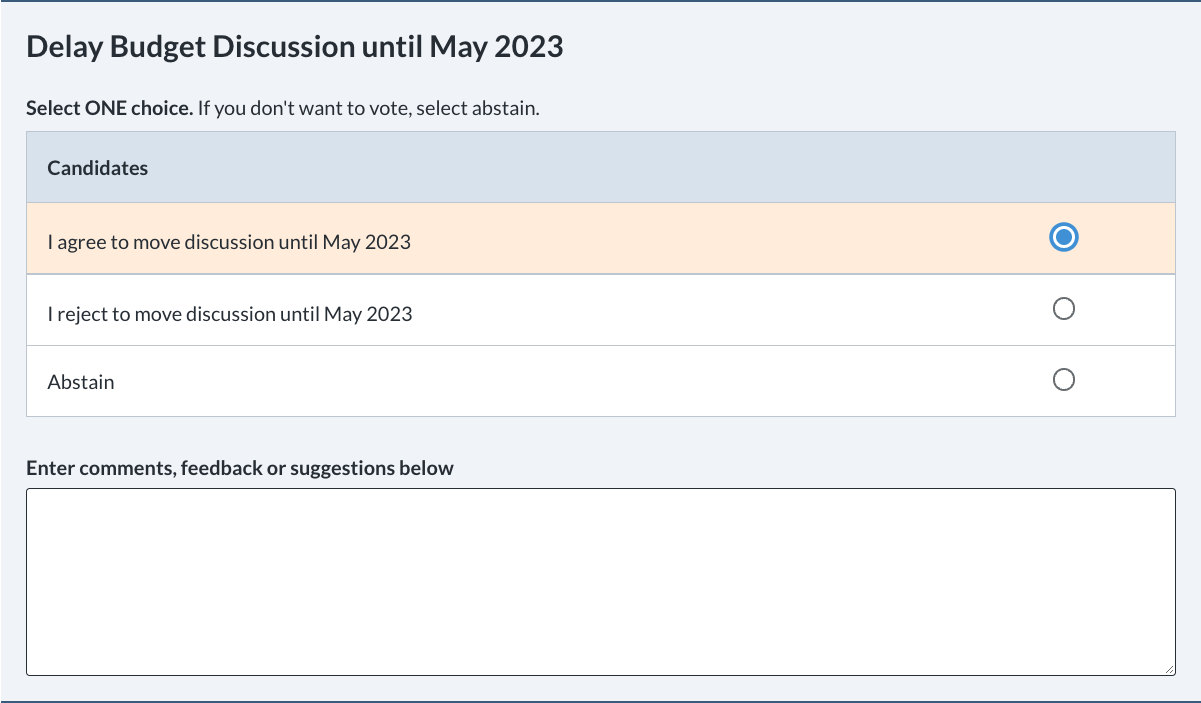ElectionBuddy easily handles voting on motions

Common features used when building a ballot for a motion vote include:
Some governing bodies will only allow certain individuals to put forward motions at meetings - in the hope that order is properly maintained. However, other governing bodies will allow any individual within the body to put forward their ideas. Like presenting a motion, the rules surrounding who can make motions will be laid out in the governance policies established by the board. That's why taking the time to read through and create such policy documents is crucial. In a democratic society, the majority of us will want anyone at a meeting to be able to put forward a motion to vote upon. However, the practicalities of allowing that to happen sometimes necessitate rules limiting who can make a motion at a board meeting to a select few.
Seconding a motion is when another member of a collective body supports the motion being discussed for wider agreement. Seconding a motion can be a helpful procedure to have in place as it means that only motions that have some form of support from other members are debated for a future vote. That can be very helpful as it means that minimal time is wasted discussing a motion that no one, other than the person proposing it, supports. As a result, it can help instill order at a meeting with many members. It means that those at a meeting make optimal use of their time and only ever discuss issues that are truly worthwhile. Some governing bodies will therefore have strict rules surrounding what seconding a motion requires from other members.
Earlier, we identified that a motion is a proposal that a member of a board, governing body, or collective puts forward to other members at a meeting to discuss. When the motion is debated by those at a meeting, it helps bring about a resolution to the issues that the person bringing forward the motion has highlighted. When a motion is passed, therefore, it means that members of the board or collective have voted for what the motion proposer has suggested.
The rules that surround how to vote for motions will depend on what rules the members of a governing body put in place. In some instances, the governing body will want a simple majority to pass a motion, whereas some will want a ballot where there is the aforementioned two-thirds majority - among any other relevant rules which have been put in place to make voting on motions a fair process.
The voting process for a motion will not always necessitate a great deal of work - in some instances, simply a show of hands is enough for the vote. However, in other meetings, board motions will require members to use a more sophisticated procedure that follows all the established internal rules before the vote can take place and be considered valid.
Like the rules that surround making a vote for a motion at a meeting, the steps that members should take to present a motion will be different among governing bodies. The key is to outline those steps clearly so that all members know what is required of them at a meeting, should they want to put forward an idea for other members to vote upon.
In some instances, a vote will necessitate having formal documentation submitted to all board members prior to a meeting, while in other scenarios all that will be needed is for members to have the opportunity at a meeting to discuss any relevant business.